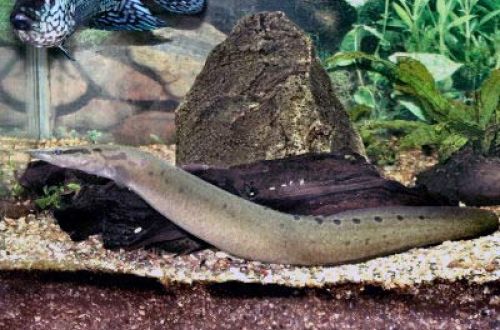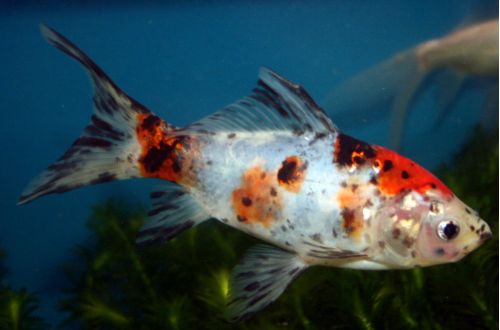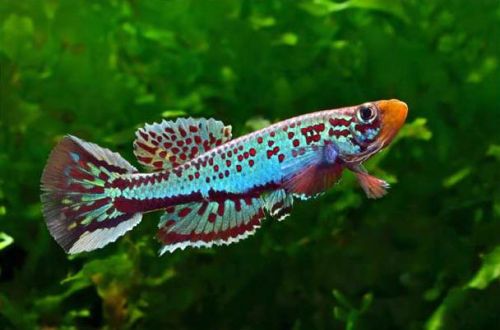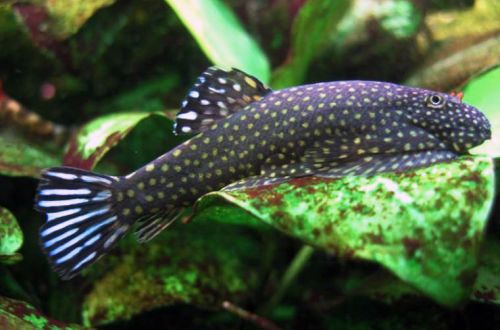
Siamese macrognathus
Siamese macrognathus, scientific name Macrognathus siamensis, belongs to the family Mastacembelidae (proboscis). Belongs to the group of acne. It occurs naturally in Southeast Asia. The natural habitat extends over the vast expanses of the Chao Phraya and Mekong river basins in what is now Thailand. Inhabits shallow parts of rivers with soft substrates, in which it periodically burrows, leaving its head on the surface.

Contents
Description
Adult individuals reach a length of up to 30 cm. The fish has an elongated snake-like body shape and a pointed head. The dorsal and anal fins are located closer to the tail, forming a single fin with it.
The body color is light brown with a pattern of beige stripes running along the body from the head to the base of the tail. There are 3-6 round black spots on the edge of the dorsal fin. Due to this feature, this species is sometimes referred to as Peacock eel.
Outwardly, it resembles its close relative, the Prickly Eel, which lives in similar biotopes.
Behavior and Compatibility
Leads a hidden nocturnal lifestyle. Shy, should be avoided with territorial and overly active species. For example, with caution, you should select fish from among the goltsov and catfish, with the exception of the harmless Corydoras.
Compatible with most peaceful species of comparable size. Small fish that can fit in the mouth of the Siamese macrognatus can probably be eaten.
Brief information:
- The volume of the aquarium – from 150 liters.
- Temperature – 23-28°C
- Value pH — 6.0–8.0
- Water hardness – soft to hard (6-25 dGH)
- Substrate type – sandy
- Lighting – subdued
- Brackish water – no
- Water movement – moderate
- The size of the fish is about 30 cm.
- Nutrition – foods high in protein
- Temperament – conditionally peaceful
- Content single or in a group
Maintenance and care, arrangement of the aquarium
The optimal aquarium size for 2-3 eels starts at 150 liters. Being a bottom dweller, the main emphasis in the design is given to the lower tier. It is recommended to use a soft sandy (or fine gravel) substrate and provide several shelters in the form of caves and grottoes. The lighting is subdued. Floating plants will serve as an additional means of shading. Since the Siamese macrognathus loves to dig into the ground, rooting plants are often uprooted.
For long-term maintenance, it is important to provide soft to medium hard water with slightly acidic or neutral pH values, as well as high levels of dissolved oxygen. Additional aeration is welcome.
Aquarium maintenance is standard and consists of a weekly replacement of part of the water with fresh water and the removal of accumulated organic waste (food leftovers, excrement).
Food
In nature, it feeds on insect larvae, small crustaceans, and worms. On occasion, it can eat fry or small fish. In a home aquarium, high protein foods such as earthworms, large bloodworms, pieces of shrimp meat should become the basis of the diet.
Being a nocturnal inhabitant, food should be served shortly before turning off the main light.
Fish diseases
The habitat is of key importance. Unsuitable conditions will inevitably affect the health of the fish. The Siamese macrognatus is temperature sensitive and should not be kept in cool water below the recommended values.
Unlike most scaly fish, eels have relatively delicate skin that is easily damaged by tools during aquarium maintenance.
Read more about symptoms and treatments in the Aquarium Fish Diseases section.





